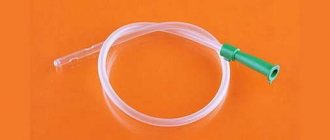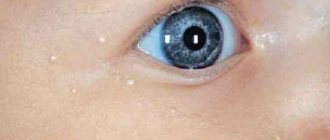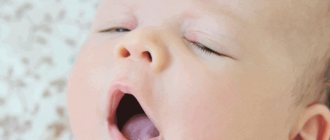When do babies start to have tears when they cry?
All young parents have probably noticed that when their baby screams, making itself known, then, although it is called a child’s cry, the tears do not flow.
The fact is that in newborns the glands that produce tears are not yet activated. They normally begin to function in the first few weeks of a child's life.
IMPORTANT: Some parents talk about the appearance of tears in their child after 1, 5, and some - after 2 months. Ophthalmologists determine the period to be 2-6 weeks. If tears do not appear later, you should talk to your doctor about it.
Anatomy of the human lacrimal apparatus.
So what physiological characteristics of a small organism should parents know about in order to ensure that everything is normal and developing in their baby on time?
For normal functioning, the eyes must be regularly moistened, and it is tears that help control and maintain the moisture of the visual organs, protecting them from dust and irritation.
- The baby's eyes in the womb are moistened by amniotic fluid.
- The ducts through which tears emerge originate in the conjunctival plane. There is a so-called lacrimal sac, connected to the nasal cavity and opening outward by lacrimal canaliculi.
- The openings of the tear ducts are located at the edge of the eyelids near the nose. There is a mucous fold there that acts as a kind of locking valve.
- In an unborn child, tears do not come out of the conjunctival plane because it is blocked by a plug of mucus.
- This mucus plug resolves in babies soon after birth, some within a few weeks.
In the first days and weeks of life, a newborn cries without tears.
Unfortunately, sometimes in newborns the duct outlet closed by a mucus plug can cause purulent or serous-purulent dacryocystitis. This manifests itself as a yellow sticky discharge from the eyes, possibly from one eye, of the infant.
What should parents do before their newborn starts crying?
A newborn baby needs careful care and hygiene of all organs, including the eye.
The baby's eyes must be washed at least twice a day with a swab dipped in boiled water. The water temperature should be above room temperature. The procedure is carried out as follows:
- adult washes hands
- he soaks cotton swabs in warm boiled water
- use a swab to wash the line of eyelashes towards the inner corner of the eye
- never use one tampon for both eyes of the child
From time to time, and if the need arises, the baby's eyes can be washed with a weak solution of chamomile infusion or string.
Newborn eye care.
IMPORTANT: The advice to drip breast milk into a baby’s inflamed eye as a “fail-safe remedy” can be heard from many older women. But pediatricians categorically do not recommend doing this. Milk is really necessary for the baby, but as food. Fatty in composition, in the environment it becomes a breeding ground for bacteria. While its medicinal properties when used externally are very doubtful.
If tears don't appear for a long time
There is no clear definition in how many months tears should appear. It all depends on the baby’s development: for some a little earlier, for others a little later. But by 4 months, tears should appear in all babies. If this does not happen, then this may indicate a blockage of the tear ducts. The first tears should soften the plugs of amniotic fluid that plug the canals. But in 5% of babies, the canals may be narrow, and the plug simply cannot come out. In this case, you need to consult an ophthalmologist. He will prescribe special softening drops to clean the canals.
In addition to using drops, you can give your child a special massage that stimulates the excretory tract. To do this, you need to gently massage the inner corner of the eye clockwise with your little fingers 5 times a day. If drops and massage do not help, and suppuration occurs, a bougienage procedure may be prescribed. Its essence lies in the fact that a small probe is inserted into the tear duct, which clears the paths for tears and makes the ducts wider.
If there are no problems with tear production, then this is not at all a reason not to visit an ophthalmologist. The doctor should regularly examine the baby's vision organs to check whether they are developing normally. He will look at whether the eyelids function well, whether the child is able to see, whether the optical media are transparent.
Tears in newborns: Komarovsky
If it did happen that the child’s tear ducts did not open in time or were inflamed, dacryocystitis appeared, then the popular pediatrician and TV presenter Komarovsky denies the possibility of a medicinal solution to the problem unless an emergency arises.
Massage for dacryocystitis.
As you know, Dr. Komarovsky always insists that a child does not need antibiotics, including in the form of eye drops, unless absolutely necessary. Komarovsky considers massage one of the effective ways to treat dacryocystitis. The procedure stimulates the flow of tears to the openings of the ducts, due to which the film that blocks their exit to the outside is torn.
Why do newborns have no tears?
When born, the newborn emits a loud, distinct cry - a sign of health and energy. It's a cry that new parents will have to quickly get used to in the coming days and weeks. But if you look closely, you will see that the cry of a newborn is slightly different from the cry of an older baby: a newborn has no tears.
Anyone who has spent time with a newborn knows that babies are swaddles and nappies made up of mucus, saliva, hiccups and poop. With their ability to secrete seemingly any kind of liquid, it is curious that they don't actually release tears when they cry.
Tears are, of course, necessary to protect the eyes and keep them moist. When we encounter strong emotions such as sadness, anger or even happiness, we cry, said Sage Timberline, a pediatrician at the University of California, Davis, children's hospital in Sacramento, California. This temporary stress triggers the fight-or-flight response, which triggers tears to further protect the eyes. Emotional tears can also help release stress-causing hormones that may have built up during difficult times; this contributes to that feeling of relief that follows intense crying.
However, babies' tear ducts are not entirely functional at birth. They produce enough tears to make your eyes moist, but not enough to form droplets that run down those chubby cheeks. Only three to four weeks after birth can babies have full-blown tearful crying sessions. For some children this may take up to two months.
The skin of a newborn, as a rule, is also dry. No matter how hot it is, a newborn hardly sweats for the first couple of weeks of his life. This is because the sweat glands are also not yet fully functional. At first, sweat may appear on the child’s forehead only.
Because newborns cannot sweat completely, they rely on caregivers to care for them. Watch out for signs of overheating, which include: sweating (as newborns do produce some sweat); warm, flushed skin; rapid breathing; fussiness; decreased activity of the arms and legs. If your baby is too warm, simply remove a layer of clothing or turn on a fan to improve air circulation. And also do not forget to ventilate the room more often.
Of course, young children also cannot walk, talk, or digest solid food. It takes time to learn to function fully correctly. The only thing that seems fully functional from day one is their vocal cords.
Tags: children
Rate this article:
(votes: 2 , rating: 3.00 out of 5)
Read us on our channel in Yandex.Zen
Why does the baby cry without tears?
Experts say that crying for a newborn baby is a special means of communication with the outside world. Thus, he wants to make a statement and attract the attention of others.
In the first days after birth, the baby will not smile when communicating with mom or dad, because when smiling, the facial muscles are involved, which begin to be controlled by the subcortex of the brain only a week after birth.
When a baby begins to cry, the facial muscles begin to change unconsciously. Tears in this process act as a concomitant reaction to changes in the facial muscle corset.
In newborns, systems and organs actively develop in the first month of life. However, their development does not occur simultaneously, so for some time mothers may notice that the child is crying, but no tears are falling from the eyes.
The tear ducts begin to function only after a month or a month and a half. In some cases, the first tears can be seen three weeks after birth, it all depends on the individual development of the baby.
Read also: For or against: 10 facts about parents and children sleeping together
The absence of tears in the first period after birth is due to the physiological structure of the body. When the baby is inside the mother's womb, he does not need tears, since the amniotic fluid fully performs their function. Tear ducts begin to function only a certain time after the baby is born.
Baby eye care
Until the baby’s cleansing lacrimation process is fully developed, this function will fall on the shoulders of the parents. During hygiene procedures in the evening and morning, it is necessary to carefully examine the child’s eyes. When washing, it is necessary to additionally clean each eye with boiled water. To do this, use cotton swabs soaked in warm boiled water. It is necessary to clean the eye in the direction from the temple. A separate cotton swab should be used for each eye.
You can use herbal infusions to rub your eyes, but only if your doctor allows it. Chamomile infusion acts as a good antiseptic.
Pour a glass of boiling water over a teaspoon of crushed chamomile flowers, let it brew and cool to room temperature. When using decoctions, the fact of filtering is important, since no small particles should be in the solution for washing. This can scratch and irritate the delicate lining of your baby's eyes.
In some cases, the doctor prescribes antiseptic solutions for wiping the eyes. Slightly diluted solutions of potassium permanganate or furatsilin are well suited for this purpose. Potassium permanganate must be used with extreme caution.
The appearance of the first tears
Note to young parents. In a newborn baby, tears should appear in both eyes at the same time. If tears come from only one eye, this is a signal that the second tear duct cannot function, for example due to suppuration, a narrow duct or dysfunction. In this situation, it is necessary to consult an ophthalmologist to determine the cause.
The closing plugs of the lacrimal canals, which are clogged in newborns, completely resolve within a few weeks and by 1-2 months of life, tears begin to flow into the eyes.
The first tears can be either abundant or scanty. Literally a couple of drops can roll down the baby’s cheek. For the first appearance of tears, any volume is normal.
If the baby is already more than two months old, and tears have not appeared when crying, this is a reason for concern and contacting a specialist.










